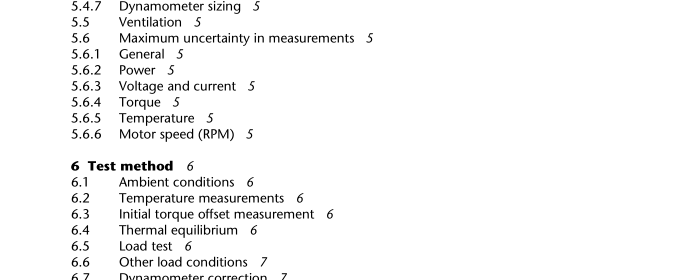CSA C747-09 pdf download – Energy efficiency test methods for small motors.
2 Reference publications This Standard refers to the following publications, and where such reference is made, it shall be to the edition listed below, including all amendments published thereto. CSA (Canadian Standards Association) C22.2 No. 1 00-04 (R2009) Motors and generators CAN/CSA-C60044-1 -07 Instrument transformers — Part 1: Current transformers CAN/CSA-C60044-2-07 Instrument transformers — Part 2: Inductive voltage transformers IEEE (Institute of Electrical and Electronics Engineers) 1 20-1 989 Master Test Guide for Electrical Measurements in Power Circuits NIST (National Institute of Standards and Technology) Technical Note 1 297 (1 994) Guidelines for Evaluating and Expressing the Uncertainty of NIST Measurement Results 3 Definitions The following definitions shall apply in this Standard: Continuous duty — operation at a constant rated load for a duration sufficient to reach thermal equilibrium. Dynamometer test — a test in which the mechanical power output of a machine acting as a motor is determined by the shaft torque, by means of a dynamometer, together with the rotational speed. Efficiency — one of the following ratios, determined in consistent units and expressed as a percentage: (a) output/input; (b) (input – losses)/input; or (c) output/(output + losses).
Full load — (a) for air-over motors, the measured power output at nameplate rated voltage and current. For multiple-tap air-over motors, the rated load at the highest speed tap; (b) for variable speed motors that require a converter to operate, the rated power output at the speed specified by the manufacturer; or (c) for all other motors, the rated horsepower of the motor. Input — the electrical power measured at the line connection. Load — all numerical values of the electrical and mechanical quantities that signify the demand made on a motor. No load — the state of a motor running while disconnected from any load.
Nominal efficiency — the average efficiency at full load of a large population of motors of the same design (see Clause 7). Output — the mechanical power measured at the shaft of a motor. Rated value — the numerical value of a quantity included in the rating. Rating — the numerical values of the electrical and mechanical quantities, as well as their duration and sequence, assigned to the motor by the manufacturer and stated on the rating plate. Thermal equilibrium — the state in which a constant temperature is reached and the observed temperature rise of the motor does not vary by more than 1 °C over a period of 30 min.
Total loss — the difference between the input and the output. Uncertainty of measurement — a parameter associated with the result of a measurement that characterizes the dispersion of the values that could reasonably be attributed to the measurand. Notes: (1) The parameter can be a standard deviation (or a given multiple of it) or the half-width of an interval having a stated level of confidence. (2) Uncertainty of measurement consists of many components. Some components are evaluated using the statistical distribution of series of measurements and can be characterized by experimental standard deviations. Other components, which can also be characterized by experimental standard deviations, are evaluated using assumed probability distributions, based on experience or other information. (3) The result of a measurement is the best estimate of the value of the measurand; all uncertainty components, including those arising from systematic effects (e.g., components associated with corrections and reference standards), contribute to dispersion. (4) For further information, see NIST Technical Note 1297. 4 General requirements The construction of motors to be tested to this Standard shall comply with CSA C22.2 No. 1 00. Where a motor requires a converter to operate on alternating current, the motor and converter shall be tested together. 5 General test requirements 5.1 General All quantities shall be rms values unless otherwise specified. Note: Deviations from sine waveform, balanced supply voltage, and rated frequency will result in the motor having greater losses and lower efficiency and should be avoided.CSA C747-09 pdf download.
